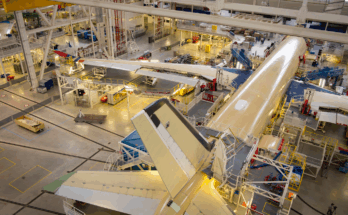By Bill Ostrove, Space Systems and Military Markets Analyst, and Raymond Jaworowski, Senior Aerospace Analyst, Forecast International.

Although weather caused the 2016 Farnborough Air Show to get off to an inauspicious start, the excitement picked up later in the week.
Rain
On the first day of the 2016 show, rain came down so heavily that management was forced to shut down power and evacuate attendees. Most of the day’s flight demonstrations, including the F-35B Lightning II, were canceled. While some of the chalets had backup power that enabled them to remain open, most of the day’s business was postponed until later in the week.
Orders
As we expected, order activity at Farnborough this year was down compared to last year’s Paris Air Show, and compared to the 2014 Farnborough show. Orders and other commitments for commercial airliners (including regional jets and turboprops) announced at the show totaled just over 850.[i] This compares to around 1,200 orders and commitments announced at the 2015 Paris show and the 2014 Farnborough event.
The order slowdown is indicative of a number of factors: low fuel prices, lessening the need to replace older aircraft with new; weakening sales of legacy airliner models that are soon to be replaced in manufacturer product lines by new variants; and continuing economic sluggishness in key regions of the world.
Moreover, a major order by SpiceJet that many hoped would be signed at Farnborough never materialized, further reducing the numbers.
Despite the slower sales activity, both Airbus and Boeing had good shows. Airbus garnered orders and commitments for 279 aircraft, including 197 firm orders and 82 other commitments. All but 10 of the 197 firm orders (and all 82 other commitments) were for narrowbody airliners in Airbus’ A320 family of aircraft. And the bulk of these were for the A321neo – the largest of Airbus’ narrowbody models. The largest A321neo order was a $12 billion deal with AirAsia.
Boeing announced orders and other commitments for 182 commercial aircraft, including 62 firm orders and 120 other commitments. Most of the orders were for 737 narrowbodies, particularly the new 737 MAX models. Also of note was an agreement with the Russian firm Volga-Dnepr Group finalizing the terms for an acquisition of 20 747-8F freighters – a deal that is important in regard to the future production life of the 747. Boeing’s largest deal, worth $4.1 billion, was with China’s Donghai Airlines for 25 737 MAX 8’s and five 787-9 Dreamliners.[ii]
Boeing also had a big show on the military side of the market, as the British Ministry of Defence announced a deal to buy 50 AH-64E attack helicopters and confirmed a purchase of nine P-8A Poseidon maritime patrol aircraft.
Brexit
Leading up to the show, the recent Brexit vote created uncertainty and cast a shadow on preparations. However, most people in attendance did not seem to think that Brexit would seriously hurt business going forward. Many people expressed optimism that deals will be worked out that enable the U.K. to continue to play a major role in the global aerospace industry. The P-8 and Apache deal highlighted that impression.
Further illustrating the continued role in the global aerospace industry that the U.K. intends to play was the U.K. Space Agency’s announcement that it would spend GBP4.12 million ($5.4 million) to invest in a new space propulsion testing facility. The facility will be open to commercial companies, enabling them to test technologies needed to compete in the global launch market.
F-35
One of the highlights of the show was a hovering demonstration by the F-35B. The B is the STOVL variant of the F-35 that will be purchased by the U.S. Marine Corps and U.K. Royal Navy. The aircraft maintained an almost perfectly still hover for nearly two minutes. After years of delays, the F-35 appears nearly ready to take over as one of the world’s primary fighter aircraft.
Russia
Notably absent from the show were Russian aircraft displays. Other than the commercial Sukhoi Superjet 100, there were no Russian aircraft, either in the static displays or doing flight demonstrations. Apparently tension between the West and Russia prevented Moscow from sending military aircraft to Farnborough in 2016. As this author had never been to Farnborough before, the famous acrobatic displays of Russian fighter jets were missed.
[i] http://www.farnborough.com/trade/page.cfm/action=Press/libID=1/libEntryID=47/listID=1
[ii] http://www.investors.com/news/airbus-beats-boeing-in-airshow-orders-overall-orders-lagged/
A military history enthusiast, Richard began at Forecast International as editor of the World Weapons Weekly newsletter. As the Internet grew in importance as a research tool, he helped design the company's Forecast Intelligence Center and currently coordinates the EMarket Alert newsletters for clients. Richard also manages social media efforts, including two new blogs: Defense & Security Monitor, covering defense systems and international issues, and Flight Plan, which focuses on commercial aviation and space systems. For over 30 years, Richard has authored the Defense & Aerospace Companies, Volume I (North America) and Volume II (International) services. The two books provide detailed data on major aerospace and defense contractors. He also edits the International Contractors service, a database that tracks all the contractors involved in the programs covered in the FI library. More recently he was appointed Manager, Information Services Group (ISG), a new unit that encompasses developing outbound content for both Forecast International and Military Periscope.




